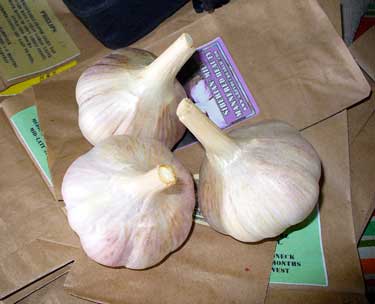Garlic Storage
Garlic is a living plant. Storage length of garlic depends on your storage conditions. To keep garlic for the longest storage time, place garlic in a cool (47-65ºF) dry area such as an unheated room. Do not store garlic in plastic or air tight containers or garlic will mold, rot or try to grow.
Do not freeze garlic if you want to plant it later (freezing will kill the bulb). Garlic can easily survive freezing IF it is in the ground and growing roots but not if it is in the freezer.
Use a Brown Paper Lunch Bag to Store Garlic
For best results store garlic in a loosely closed lunch sized paper bag, a lunch sized paper bag with small holes punched in it for ventilation, or loose in a cardboard box in a cool area (don't pile too many on top of each other or they will mold on the bottom layer). Garlic needs to be in a well ventilated area. 
Picture: For some reason we have a surplus of brown paper bags (which are made from recycled paper). Romanian Red garlic bulbs hold down a few garlic bags.
If you grow your own garlic make sure to cure it properly before you store it. Garlic that is not cured enough has a greater risk of rot. We cure our garlic for 3-6 weeks depending on the weather and humidity (and we live in a fairly dry climate).
So how well does the paper bag storage work? I can eat garlic in April from all the varieties I harvested in August (that is over 7 months). The garlic bulbs were stored in the fall in paper lunch bags jumbled in a cardboard box in an unheated mudroom (stays above freezing in winter).
Over 95% of the cloves are very plump (all cloves are still good). Since it is a little chilly some of the cloves have small root buds or a small green bud (not a sprout - just thinking about it). When the storage area gets warmer there is more sprouting. All the garlic varieties still taste good.
Places Garlic Will Rot:
- On top of refrigerator
- In air tight containers
- In plastic bags
- By heaters
- In trunk of car
- Near a fireplace
- By the jet engines of your private plane

Picture: Garlic bulb in plastic.
Places Garlic Will Grow or Sprout:
- Refrigerator
- Any area where temperature dips below 45 F
- Outside
- In a pot
- In the soil (which is where you want it to sprout!)
Places Garlic Will Get Eaten:
- On kitchen counter
- In lasagna
- In garlic dip
Other Ways To Preserve Garlic:
- Dry garlic in food dehydrator (cut peeled cloves in strips or halves) at around 115°F. Remove when crisp and store in a airtight container.
- Mince fresh garlic cloves, add a little water and store in the freezer as garlic ice cubes. Please make sure to distinguish these from the real ice cubes in the freezer! Tip: freeze the amount you like to use in individual cubes.
- Roast garlic heads (bulbs), cut off top, squeeze out garlic and freeze (in convenient dollops). Store in airtight container in freezer until ready to use.
- Don't store garlic cloves in oil at room temperature. It is unsafe and can breed botulism. So why can this cause botulism? There is NO oxygen due to the oil, garlic is a low acid bulb and it is warm. This is an ideal condition for dangerous botulism toxins to develop. Don't risk your health for garlic oil, botulism is not your run of the mill food poisoning - it can kill you or paralyze you. You can store freshly combined garlic and oil in the freezer.
- Make black garlic.
What Happens to Garlic During Storage?
Researchers stored garlic bulbs at room temperature and 4°C for up to six months (Hughes et al. 2006, Ichikawa et al 2006). Interestingly, concentrations of alliin, gamma glutamyl allyl cysteine sulphoxide and gamma glutamyl isoallyl cysteine sulphoxide were significantly higher in the outer cloves than in the inner cloves .
There was no change in alliin concentration in garlic stored at 4°C, (alliin range was 17.5+/-3.8-39.1+/-7.5 mM). Isoalliin increased significantly during storage at 4°C, from an average of 0.6+/-0.2 mM (outer cloves) to 0.7+/-0.4 mM (inner cloves) to 7.1+/-1.7 mM (outer cloves) to 4.1+/-0.7 mM (inner cloves).
The other sulphur-containing gamma-glutamyl peptides, gamma-glutamyl allylcysteine sulphoxide and gamma-glutamyl isoallylcysteine sulphoxide, declined (Ichikawa et al. 2006). These two compounds convert to alliin and isoalliin. Interestingly, during warmer storage (23°C) more isoalliin is converted to cycloalliin. This does not occur under cold storage.
Garlic Varieties and Storage
Some garlic varieties store longer than others. Almost all garlic will last 5-7 months under good conditions. The longest storing garlic we grow is Thermadrone. It can last over 9 months under ideal conditions (we have had some last 9 months under really poor conditions). Chesnok Red is also a long storing garlic. Georgian Crystal and Romanian Red are good storing garlic under ideal conditions.
References:
- Hughes J, Collin HA, Tregova A, Tomsett AB, Cosstick R, Jones MG. Effect of low storage temperature on some of the flavour precursors in garlic (Allium sativum). Plant Foods Hum Nutr. 2006;61:81-5. Pubmed.
- Ichikawa M, Ide N, Ono K. Changes in organosulfur compounds in garlic cloves during storage. J Agric Food Chem. 2006;54:4849-54. Pubmed.
